K2 DVDs
My rating scale:
 Excellent ;
Excellent ;
 Very Good ;
Very Good ;
 Good ;
Good ;
 Fair ;
Fair ;
 Poor.
Poor.
1. The Summit
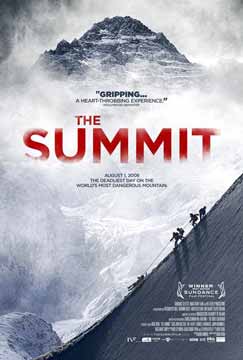
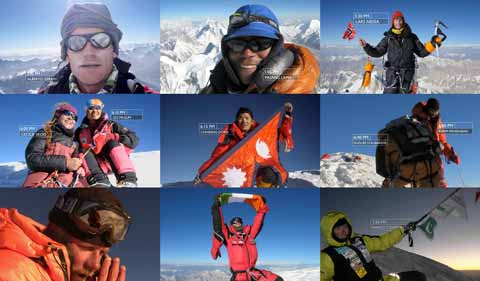
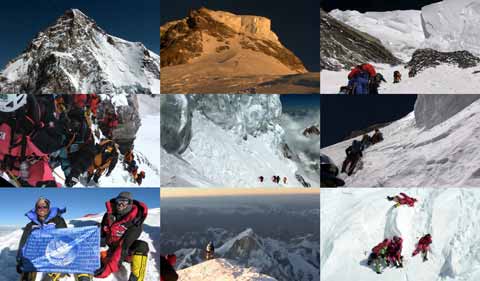
Released 2012. 103 minutes. Produced and directed by Nick Ryan. Executive producers Pat Falvey and John McDonnell. 2008 K2 footage by Hoselito Bite, Gerard McDonnell, Fredrik Strang and Wilco van Rooijen. Interviews with Wilco Van Rooijen, Pemba Gyalje Sherpa, Marco Confortola, Cecilie Skog, Lars Nessa, Frekrik Strang, Eric Meyer, Alberto Zerrain, Cas van de Gevel, Hoselito Bite, Pasang Lama, Tsering Lama, Annie Starkey, Pat Falvey, Damien O'Brien, JJ McDonnell. There is also an interview with Walter Bonatti and some footage from the 1954 Italian expedition.
In the early morning hours of August 1, 2008 25 climbers set out from camp 4 to reach the summit of K2. But first they have to climb the bottleneck, a rock lined corridor under a massive overhang of ice called a serac. Fredrik and Eric saw the knot of climbers at the bottom of the bottleneck seemingly not moving and decided to turn around. Combining reneactment with actual footage from camp 4, the film tells the story of Serbian Dren Mandic who unclipped from the rope and fell to his death, the attempted rescue by Fredrik and Eric, the attempt to bring Mandic's body back to Camp 4, and then porter Jehan Baig started acting really wierd and slipped and fell to his death.
Alberto fixed the way across the traverse and went on to the summit at 3:30pm followed by 17 other climbers including Pasang Lama at 5pm, Lars Nessa at 5:30pm, Lim Jae-Soo at 6pm. Celilie Skog at 6pm, Go Mi-Sum at 6:10pm, Don-Jin Hwang at 6:10pm, Kyeong-Hyo Park at 6:15pm, Chhiring Dorje at 6:15pm, Hugues D'Aubarede and Karim Meheraban at 6:40pm; Wilco van Rooijen, Cas van de Gevel, Ger McDonnell and Pemba Gyalje Sherpa at 7:20pm and finally Marco Confortola at 7:30pm. Ger: "With all extremes comes extreme beauty. And in many ways those very extremes, they are addictive." Wilco: "We were at the end of the earth; heaven almost ... Now we have to go down. Now the surviving starts."
The film moves to the world wide media frenzey on the unfolding tragedy, to Ireland and an interview with Damien O'Brien, Ger's brother in law, and then back in time to the beginning of the climb at base camp where we meet the different expeditions. The expeditions meet to plan a combined effort summit push when a good weather window is forecasted after three weeks of bad weather. When the summit plan fell apart at camp 4, Pemba Gyalje stepped in and started the climb 75 minutes behind schedule. When Wilco caught up with the first party, he noticed that the fixed ropes were set up too far down and had to get them refixed higher up.
What follows is a reenactment of the descent, with Cecilie, Lars and Rolf crossing the traverse after dark amd the first serac fall cutting the ropes and sending Rolf to his death. For the 15 climbers above, their lifeline down the mountain was gone. The exhausted descending climbers became one group, with Pemba and the Sherpas trying to lead them down on one rope. Pemba: "The Koreans completely stopped. It is completely impossible to bring them down with the same rope. Because they sit down." Pemba and two Sherpas left the group and descended to camp 4. Wilco, Ger and Marco couldn't find the fixed ropes so they stopped and waited for morning. Wilco: "We were not in a panic." Meanwhile Cas bypassed Hughes on the fixed ropes on his descent and then was using his ice axe and crampons to descend when Hughes fell to his death.
We see Pemba and the Americans in camp 4 talking about the situation in the early morning of August 2nd. Fredrick: "It was still nice and clear. We could see some of the climbers at the top of the serac." Wilco realized he was getting snowblinded so he hurried ahead to descend, passing by Koreans and Sherpa who had fallen and were tangled up in ropes. He gave one of them a pair of mitts and continued his descent. Ger and Marco also reached the Koreans and stopped to help. Marco: "It was the Korean climbing leader. But everything was smashed up with lots of blood everywhere. ... I knew this was a bad situation." Ger climbed back towards the Koreans while Marco descended. The Korean Mr Kim arranged a rescue party of two Sherpas, while the Americans started their descent.
Around noon, the two Sherpas sent by Mr Kim found a western climber still alive at the base of the bottleneck. Pemba left camp 4 and climbed up to find a collapsed Marco Confortola. He gave him oxygen and Marco started to be revive. Around 2pm, Pemba received a second radio call from the rescue team above. The Sherpas sent up by Mr Kim had reached the top of the bottleneck just beneath the serac. Pemba: "They said we see Korean Sherpa and Korean team. Now we're trying to descend together." They told Pemba there was one other climber who was with them but had fallen. Pemba knew it was Ger when they told him his down suit was red and black. Another serac fall cleared the bottleneck and Pemba was able to see "two Korean body. They are 10 metres from 2 other Sherpa's bodies." Cousins Pasang Bhote and Jumik Bhote had fallen.
Marco was rescued after 36 hours in the death zone. 18 hours later Wilco was found by Cas and Pemba. Wilco: "Everybody wants to survive." Wilco and Marco are evacuated by helicopter to be interviewed by the media frenzy. Annie and the McDonnells flew to Pakistan and filmed interviews with Wilco to try and undertand what truly happened to Ger. They then filmed an interview with Pemba who told them that the Koreans had been rescued and were descending when the serac killed them. The only possible answer was that Ger had rescued them.
The film perfectly combines live footage from the climb with reenactments and studio interviews to grip you emotionally to visualize the climb, the summit elation and the harrowing tragic descent. The filming is excellent, the narration and the pacing smooth. The film of the enormous serac from just below magnifies the Russian roulette the climbers were facing. I do not think the diversion to the 1954 Italian expedition was unnecessary in the film - in some ways it distracted from the narrative.
2. K2: El Gran Cristal Y El Leon Domado
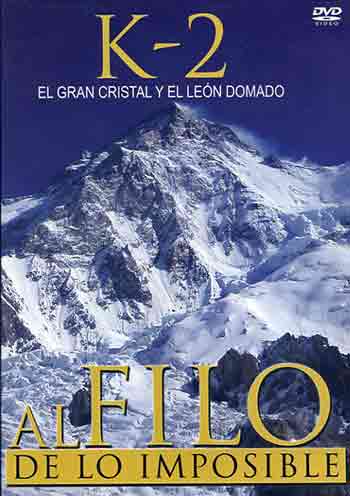
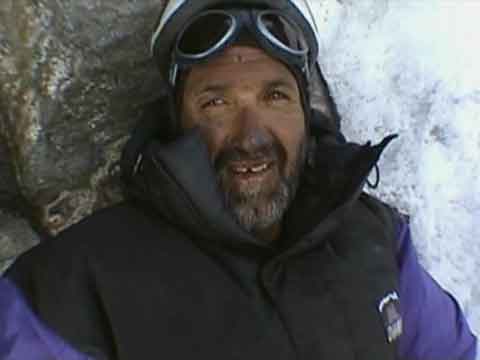

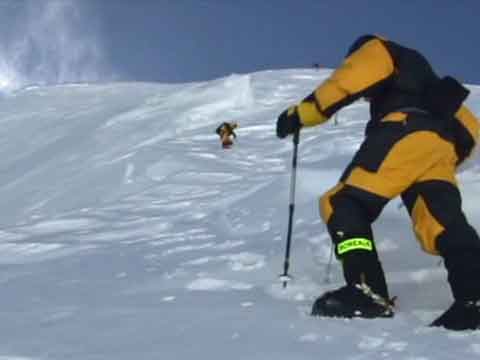
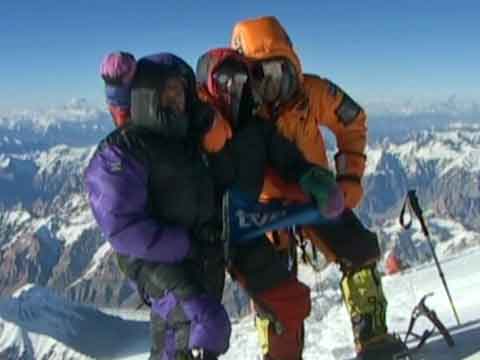
by Sebastian Alvaro. Al Filo De Lo Imposible, Spanish TV. 107 minutes. Filmed in 2004. Released 2005. This film documents the 2004 Spanish K2 Expedition from beginning to end, following Spanish climbers Juanito Oiarzabal, Edurne Pasaban, Juan Vallejo, and Mikel Zabalza as they climb K2 on the 50th anniversary of the first K2 ascent.
The film opens in the night with a distraught Alvaro at base camp talking to a high camp, who are explaining that after reaching the summit earlier in the day, Juanito Oiarzabal is lost and hasn't reached Camp 4, and asking the Italians for help to find him. They found Juanito semi-unconscious and helped him to Camp 4. An exhausted and utterly shattered Juanito struggles to come down the fixed ropes as Alvaro implores him to keep moving. Edurne Pasaban and finally Juanito arrive at Base Camp (they were airlifted out of Base Camp by helicopter, and eventually lost toes to frostbite). Phew! What an opening!
The expedition starts with the climbers driving to Askole in jeeps, the porters carrying to Base Camp, walking up the glacier, and climbing the Abruzzi Ridge to Camp 1 and digging out space for the tents. Back at Base Camp, Juanito prepares dinner and there is singing and dancing. There is a meeting between Kari Kobler of the 2004 Italian team and the other expeditions talking about fixing ropes and using tents. We also see the Gilkey memorial with the many plaques added over the years. More climbing, up House's Chimney to Camp 2, once again digging out space for their tents, with his a dizzyingly long telephoto shot showing the precariousness of the camp. They climb higher to the Shoulder and set up Camp 3, and then descend in bad weather. Up they go again, climbing fixed ropes in bad weather to Camps 2 and 3, eventually setting up Camp 4 beneath the beautiful enormous serac. There are amazing mountain views of Broad Peak, the Gasherbrums and the Karakoram.
They set off for the K2 summit in the night in high wind and very cold weather. The fixed ropes are over, and they move slowly and carefully breaking trail on ice and then very deep snow. It is like time is standing still with only occasional movement from a climber. Edurne Pasaban, Juanito Oiarzabal (for the second time), Juan Vallejo, and Mikel Zabalza reached the summit of K2 on July 26, 2004 at 16.30 along side the first two Italians from the K2 50th anniversary team, Silvio Mondinelli and Karl Unterkircher. Base camp is jubilant when they learn that Juanito has made it. Juanito is welcomed by fellow climbers as he struggles to the summit. Juanito moves in extreme slow motion as he unfurls the TVA flag for the summit photo.
Interspersed with the 2004 expedition are footage from 1909; 1929 showing crossing rope bridges; 1954 expedition and summit footage and current interviews with Ardito Desio, Achille Compagnoni, and Walter Bonatti; brief footage and photos from 1986 and a current interview with Kurt Diemberger; and 1994 footage of the K2 North Ridge and current interviews with Juanjo San Sebastian and Ramon Portilla.
The filming is absolutely excellent, showing the beauty of K2 and surrounding mountains. We also get to see all of the K2 features like the Abruzzi Ridge, House's Chimney, the Shoulder, the enormous serac, and the summit headwall. They use close up, broad view, and extreme telephoto to give the depth and scale and steepness of the climb. The opening scene was gripping. I enjoyed seeing the old film footage and especially the interview with Diemberger. I thought the summit footage with Juanito moving in extreme slow motion to unfurl the TVA flag was very moving.
3. K2: Climbing The Savage Mountain
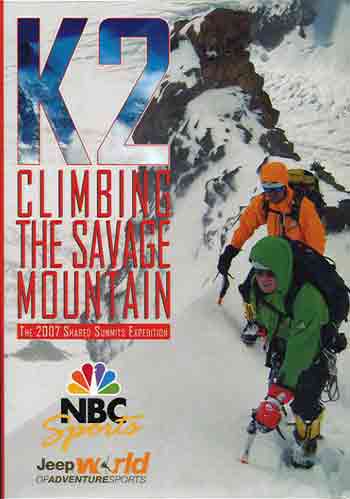
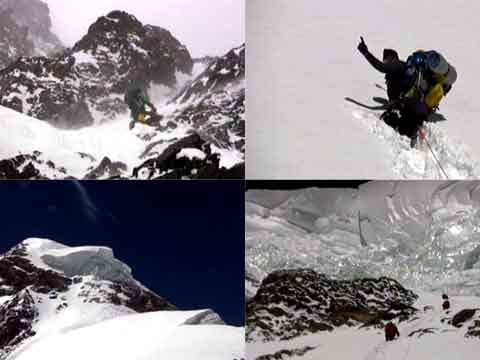

Filmed 2007. Released 2008. 44 minutes. The 2007 Shared Summits K2 Expedition, led by Chris Warner, was hosted on NBCSports.com and shown on NBC TV. The team switched to the Abruzzi Ridge after giving up on the East Face and Southeast Spur. Chris Warner, Bruce Normand and Don Bowie reached the Summit of K2 on July 20, 2007. The bonus is 6 minutes of interviews with Bruce, Chris, and Don.
There are a few quick scenes of the jeep ride to Askole and a few brief interviews. Kurt Diemberger: "K2 is the most difficult. It’s the most demanding. It is certainly one of the most dangerous 8000m peaks.” They trek to Base Camp and climb through the frightful ice fall to reach the East Face. Two hidden crevasses opened up with Chris falling into the smaller one. This was lucky because they probably would have been killed in the larger one. They attempt the East Face, setting up Camp I before they are stopped by the dizzying steep route with no place for a camp.
They return to Base Camp where they combine resources with the other expeditions to mount a unified international attempt on the Abruzzi Route. They start off a couple of times, making it to Camp 3 before being beaten back to Base Camp by the cold windy and snowy weather. They start again, go thru the icefall and climb in bad weather to camps I, II and III. Finally the weather improves, and the teams join together to break trail in the waist deep snow. They reach Camp 4 with excellent views of the Karakoram and the summit headwall. They continued climbing towards the summit, slowly crossing a very scary almost vertical ice face in their crampons. Eighteen people trudged up the deep snow to the summit.
This film graphically shows the many dangers and challenges of attempting K2, like the appalling bad weather, the icefall with huge seracs and crevasses, and the climbing. This film helps bring all the stories in the K2 books into focus. I enjoyed seeing mountaineering legend Kurt Diemberger being interviewed. There are a few annoying TV outros and intros.
4. The Conquest of K2
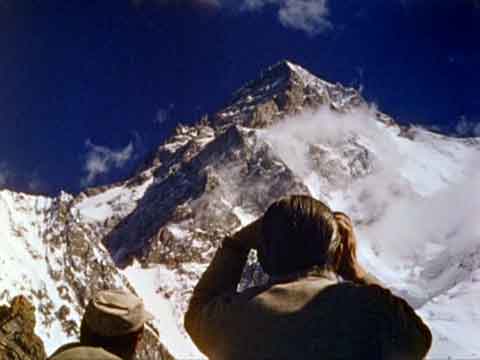
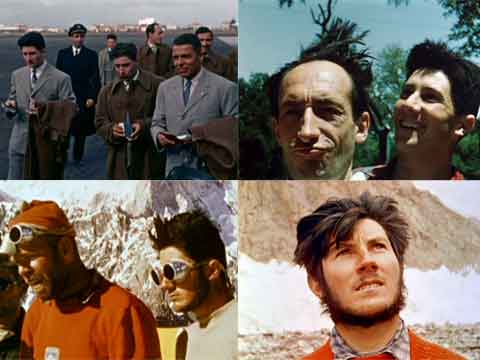

Directed by Alessandro Varchetta. Released 2004. In English. 49 minutes. This film was added to the German DVD of K2: Das letzte Abenteuer released in 2007. This film celebrates the 50th anniversary of the first ascent of K2 blending footage from the 1954 expedition with current interviews with expedition members, including Achille Compagnoni and Lino Lacedelli. There is also a brief re-enactments of Walter Bonatti's carrying oxygen up to Camp IX, which wasn't in the film.
Ardito Desio organized the expedition, but needed the Italian Prime Minister’s help to get the K2 permit, making it a state affair, a dream to unite post-war Italy. The film shows Desio lecturing the team in Italy, testing their equipment on the Matterhorn and Monte Rosa in winter, traveling to Rawalpindi, flying to Skardu and the porters carrying the supplies.
They set up base Camp and start setting up the camps and fixed ropes. Tragedy struck when Mario Puchoz died on June 21. We see a sad team bringing down his body and a small team ceremony next to his simple tombstone. They go up again in bad windy snowy weather, using a pulley system to bring supplies up to higher camps. Compagnoni comments on the weather: "We had 47 days of foul weather out of 70. It was like an affliction. We had to summon up enormous willpower to keep going." They set up Camp VIII (7700m) and got ready for the summit push.
The film deals openly with the team conflicts. Desio down at base camp had no idea what conditions were like 2000m further up. But that didn’t stop him from barking orders to the climbers in his usual military style. Bonatti and Mahdi would be the ones to carry the oxygen up to Compagnoni and Lacedelli at Camp IX, but they had moved Camp IX and Bonatti couldn't reach them. A near tragedy at the foot of the summit that night would bitterly divide the mountaineering world for 50 years. It would be an endless night; a mad struggle for survival. Lacedelli: "I have to admit that if it wasn’t for his (Bonatti's) help, we would never have got to the top."
As they near the summit Compagnoni films the Karakoram panorama from the Gasherbrums to Broad Peak and Chogolisa. They shoot film on the K2 summit of each other and the views. Compagnoni recalls his emotions on the summit: "I asked God to let me stay because it was, it was just too beautiful up there." Back in Italy the radio announced the good news. The whole of parliament applauded.
The colour in the 1953-54 footage is vibrant. I especially liked seeing the climbers in Italy dressed nicely in suits. It was wonderful to see the youthful and playful Walter Bonatti goofing around on the ship, in a Rawalpindi pool and anxiously waiting for mail. The film near the summit and on the summit is excellent.
5. Murph Goes to K2
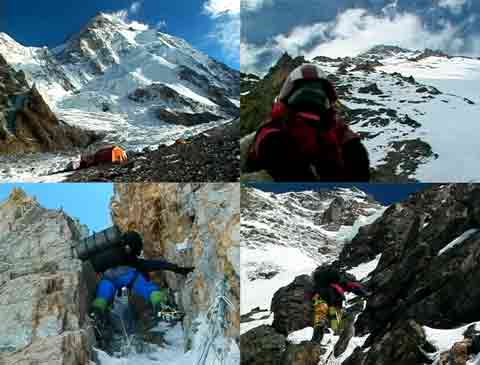
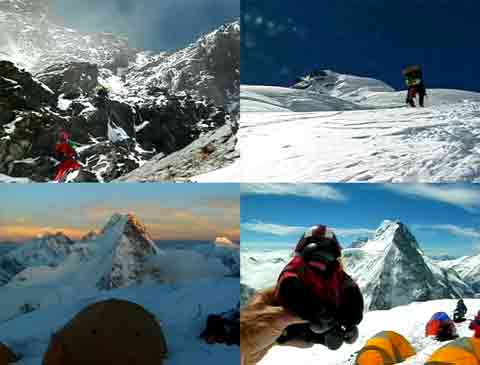
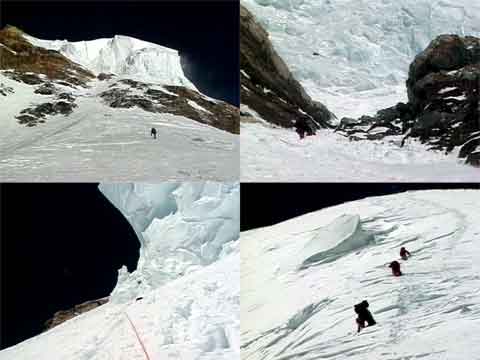

by Billy Pierson. Filmed 2000. Released 2001. 52 minutes. Billy Pierson uses a six-inch Gorilla named Murph to narrate his ascent of K2's Abruzzi Ridge as part of the International K2000 Expedition. Billy reached the K2 summit on July 30, 2000 after Chris Shaw, Andy Collins and Andy Evans.
The film follows the expedition taking a bus to Skardu on a winding narrow road in Pakistan with the frothing river below, and then continuing the drive to Askole. The porters weight loads and they trek to Paiju, wading across a river holding on to a fixed rope. Then it's on to the Baltoro Glacier with views of Trango Towers and on to Concordia and finally Base Camp where the porters are paid. Murph interviews the liaison officer, sirdar, and cook.
They start the Abruzzi ridge, slowly climbing the fixed ropes to Camp 1, and then spread eagle up House’s Chimney festooned with ropes to Camp 2. There are beautiful views of the Karakoram with the Gasherbrums and Broad Peak. They fix the black pyramid, the technical crux of the climb between 7000 and 7400m, but have to descend to Base Camp in bad weather.
They start again and climb up the snow of the shoulder, slowly panning for a magnificent sunset on Chogolisa, Broad Peak and the Gasherbrums from Camp 3 (7400m). They slowly climb to Camp 4, with yet another panorama. The next day they climb up the bottleneck past the enormous serac, and then up the summit snow slope with more panoramic views. Pierson and Murph arrive at the K2 summit and interview an emotional Andy Evans, the second Canadian K2 ascent, who is ready to descend. They get back to Camp 4 and descend to Base Camp in snowy weather. They go back up K2 to bring down the tents and gear, pack up Base Camp and trek out via Hushe.
This is an excellent home movie. The narration, background music, and camera work are very good. Murph the gorilla is funny and adds to the scenes. The film clearly shows the travel to Base Camp, the ascent route characteristics, and the weather.
6. K2 Siren Of The Himalayas
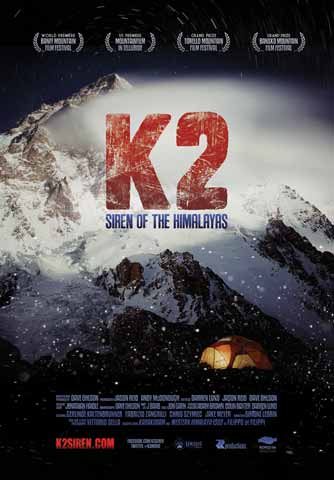
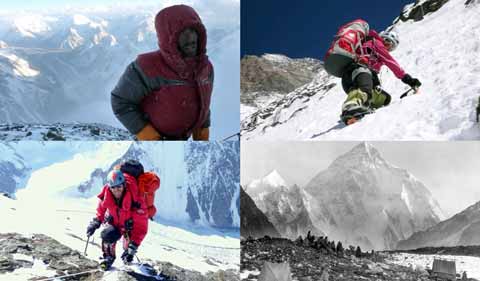
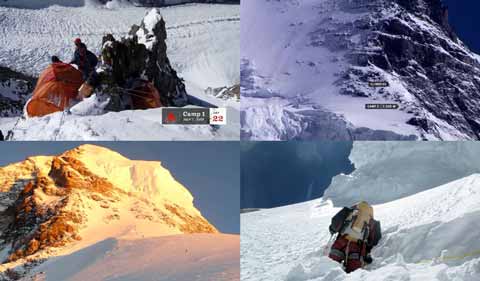
Directed by Dave Ohlson. Released 2012. 75 minutes. Narrated by Simone Leorin. Starring Fabrizio Zangrilli, Gerlinde Kaltenbrunner, Jake Meyer, Chris Szymiec. Filmed in 2009.
Mountaineers Fabrizio Zangrilli on his fourth K2 attempt, Gerlinde Kaltenbrunner with her partner and camera man David Gottler, Jake Meyer and Chris Szymiec attempt to climb K2 by the Cesan route on the 100-year anniversary of the Duke of Abruzzi's landmark expedition in 1909. Studio interviews and live interviews from base camp provide insights into why they climb. The film follows the team's journey from Islamabad to Skardu and on to Askole where they trek to Paiju, Concordia and on to base camp. On June 23 Italian skiier climber Michele Fait dies on a fall and creates a somber start to the climb. Fabrizio: "This is what we do. We have chosen to accept the consequences." Jake: "This is where we feel most truly alive." Fabrizio likens it to walking meditation.
They climb and set up camps while having to descend and wait out bad weather at base camp. In late July Fabrizio, Gerlinde and David attempt a summit push with Fabrizio turning around at camp 4 and Gerlinde and David turning around after attempting the rocks to the side of the bottleneck. They descend to base camp and have an all expeditions meeting to make one last attempt. Once again they push up the Cesan route with Jake turning around. On August 4, Gerlinde leads through the bottleneck on a beautiful sunny day, but waste deep snow halts their progress.
The documentary nicely justaposes films and photos from 1909 with 2009. The photos from 1909 are so vivid they could have been taken in 2009. The filming is excellent with just the right pacing between interviews, 1909 footage and climbing.
7. Vertical Limit

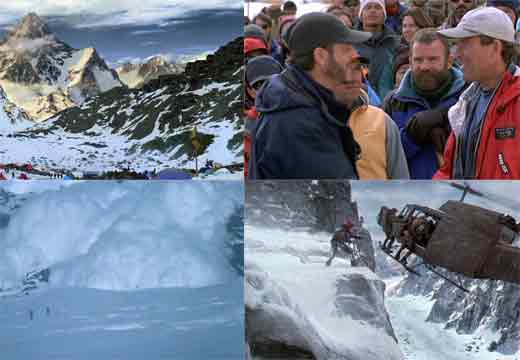
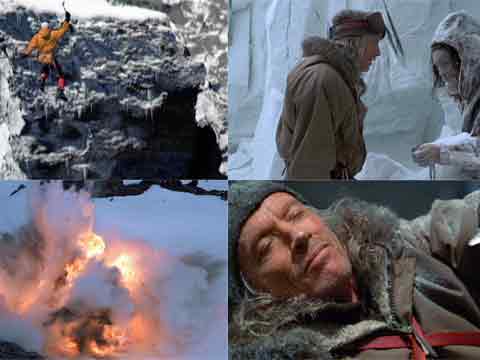
Directed by Martin Campbell. Released 2000. 124 minutes. Starring Chris O'Donnell, Bill Paxton, Robin Tunney, Scott Glenn, and a cameo appearance by mountaineer Ed Viesturs. Filmed in Pakistan, Monument Valley, and New Zealand with Mount Cook standing in for K2. The Bench brothers were based on the Burgess twins, Alan and Adrian.
Peter and Annie Garrett are an experienced brother-and-sister climbing team who have gone their separate ways after an accident claimed the life of their father. Annie has thrown herself into her climbing, claiming that only at the tops of mountains does she feel close to her father. Peter, on the other hand, has given up the sport, opting instead to pursue his love of wildlife by becoming a photographer for National Geographic. The two meet at the K2 base camp when Annie arrives with a group of climbers headed by billionaire Elliot Vaughn (Bill Paxton). As a publicity stunt for his new airline, Vaughn is determined to climb to the top of K2 so he can wave to one of his planes as it flies overhead. Leading the expedition is experienced climber Tom McLaren (Nicholas Lea), but he's really just Vaughn's puppet, bought and paid for by a $1 million check. So, when bad weather threatens and Tom argues in favour of turning back, his words go unheeded. The predictable result is a disaster (complete with an avalanche) that forces Peter to recruit an emergency rescue team and speed-climb towards K2's peak before the survivors succumb to a fatal condition called high altitude pulmonary edema. Worse still, because the survivors are trapped in an underground ice cave, Peter's group must carry canisters of unstable nitro-glycerine to blast a hole through the mountain's frozen crust.
Young climber Peter Garrett (Chris O'Donnell) risks his life to save his sister, Annie (Robin Tunney), and her summit team (Bill Paxton and Nicholas Lea) in a race against time. The team is trapped in an icy grave at 26,000 feet - a death zone above the vertical limit of endurance where the human body cannot survive for long. Every second counts as Peter enlists the help of a crew of fellow climbers, including eccentric, reclusive mountain man Montgomery Wick (Scott Glenn), to ascend the chilling might of the world's most feared peak to save her.
Extras include commentary track by director Martin Campbell and producer Lloyd Phillips; the HBO Making-Of special, Surviving the Limit (24 minutes), exploring the behind-the-scenes and preparation activities; Search and Rescue Tales that looks at the different areas of production like the sickness that climbers can face and the dangers of avalanches; and National Geographic Channel's Quest for K2 (13 minutes) takes a look at the first Americans to make it to the top of K2 in a 1978 expedition featuring interviews with people who have reached K2's summit plus older footage from previous climbs.
From a mountaineering perspective a lot of the scenes are a bit silly, but this is Hollywood, so get over it and enjoy the action. I liked the action packed, edge of your seat, high altitude scenes. The transport of nitroglycerin as a means to create tension reminds me of the 1953 thriller, Wages of Fear.
8. Quest For K2: Surviving the Summit (National Geographic)
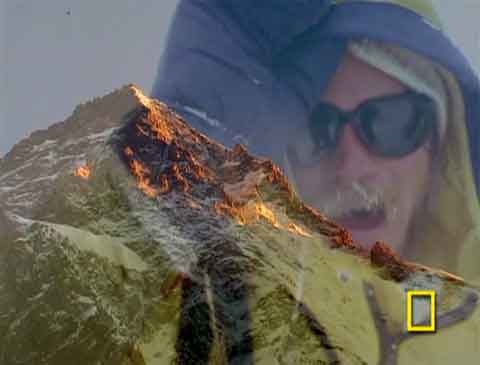
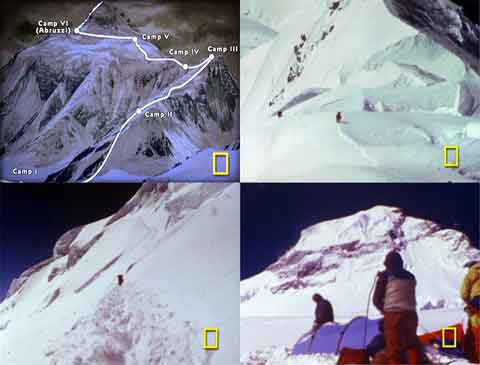

By Film Oasis. Released 2000. 13 minutes. The Vertical Limit DVD includes a K2 featurette about the first Americans to summit K2 in 1978 via the treacherous Northeast Ridge. This is a brief excerpt from the National Geographic six 30-minute TV episodes.
Jim Wickwire reached the K2 summit on September 6, 1978 with Lou Reichardt. "For me it was the culmination of this life-long dream, and I wanted to linger." And by lingering he had to suffer a solo bivouac 150m below the summit.
Rick Ridgeway reached the K2 summit on September 7, 1978 with John Roskelley. "We were on that peak above 18,000 feet for 68 days. ... Everything seemed hallucinatory. ... And we just sit there on the summit next to each other, leaning one shoulder against the other, not saying anything."
This short excerpt from the 6-part TV series features some excellent K2 scenes and footage of the 1978 American Expedition. I enjoyed seeing the interviews with Rick Ridgeway and Jim Wickwire.
9. Brotherhood of the Rope
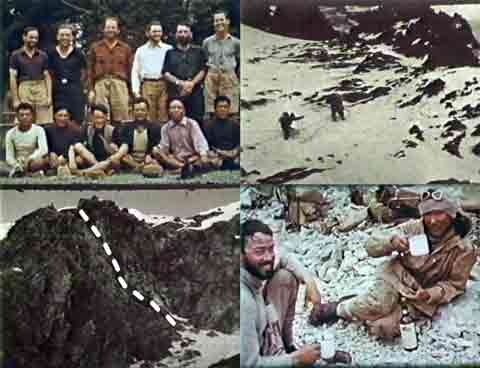
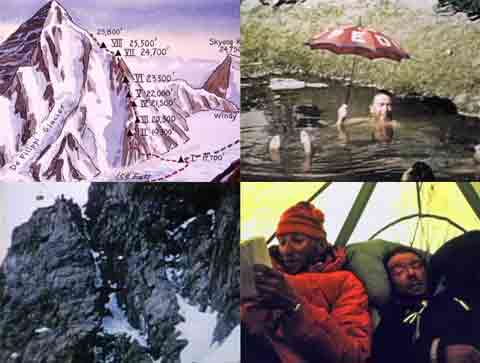
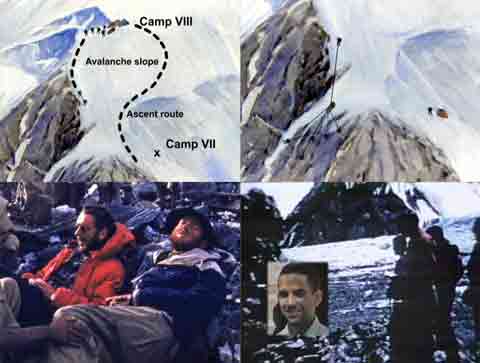
by Charles Houston. 2004. 43 minutes. This DVD, part of the book Brotherhood of The Rope by Bernadette McDonald, documents the 1938 and 1953 American K2 Expeditions. "But the rope is a bond between us, psychological as well as physical. And we always climbed roped. The bond between people whose lives are in each other's hands is an important one."
The first 9 minutes features the 1938 American Karakoram expedition. "Bob Bates and I were asked in 1938 to find a route to the summit." The film features a quick montage of scenes of Kashmir, trekking over a snow covered pass, a polo game, crossing the Indus river at Skardu, trekking to Base Camp, and climbing the Abruzzi Ridge with Bill House solving a steep rock band, now called House's Chimney. "We have found a route up the mountain ... It succeeded because we had a strong team which all worked together toward a common good."
The 1953 film starts with the flight to Skardu, crossing the Indus on a barge, scary scenes crossing rope bridges, relaxing in the hot springs at Askole, porters dancing and singing, and trekking to Base Camp. They start climbing the Abruzzi Ridge and use a pulley to drag loads up House's Chimney. The team reached Camp VIII (7800m) on August 1, but then an extended storm hits. Houston uses the team audio from August 16, 1953, photos, and illustrations from Dee Molenaar to describe the storm and subsequent desperate descent. Art Gilkey got a blood clot in his left leg as they waited out the storm.
Finally on August 10 they were able to start the descent. They wrapped Gilkey in a sleeping bag and began lowering him down towards Camp VII. Houston uses diagrams to show the descent and the positions of the team members when the accident occurred. Tony Streather: "But suddenly George was falling and he was sliding fast down this very steep ice slope. He was still tied to me ... we were all held by Pete ... and I think it was really remarkable that Pete was able to hold all five of us." Three separate ropes luckily got tangled together as the five men fell. They anchored Gilkey and went to Camp VII to set up the tents. When they went back to get Gilkey, an avalanche had ripped him from the anchors, The descent was harrowing in stormy conditions and with Houston in shock from a concussion, and Bell with frostbite in his feet and hands. They set up a memorial cairn to Gilkey near Base Camp.
I enjoyed seeing this old film footage of part of K2 history. The 1953 accident is described very well with the audio tape, photos and especially the diagrams. The colour is washed out.
10. K2
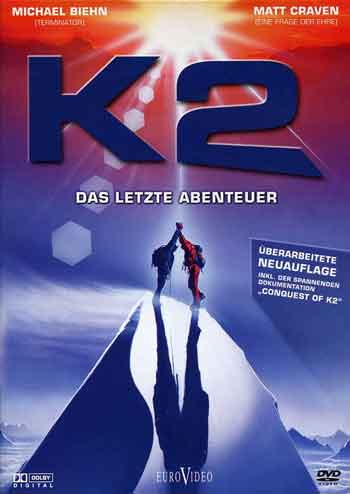
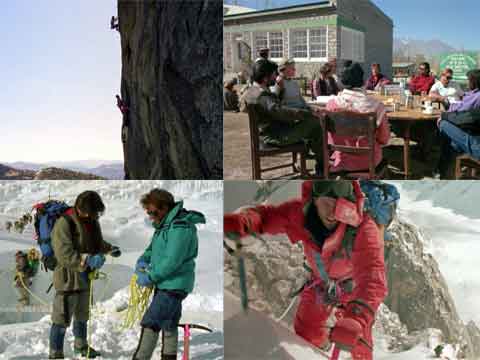
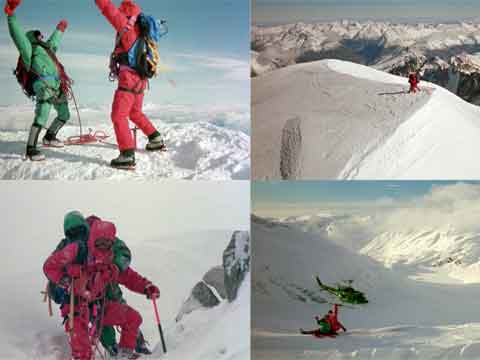
Directed by Franc Roddam. Starring Michael Biehn and Matt Craven. 1992. 106 minutes. Filmed on location in Vancouver, Whistler and Mount Waddington in British Columbia (misspelled at Colombia in the credits), and Skardu and other locations in Pakistan. This film follows two climbing friends as they climb K2. There is a 50-minute extra called The Conquest of K2.
The film is pretty true to the climbing world with snippets of: rock climbing, the young selfish climber, the family man leaving his wife and child behind, the expedition style versus alpine style climbing, avalanches, crossing a crevasse on a metal ladder, the Balti porter strikes on the way to base camp, high altitude sickness, radio communication between the climbers and base camp, ice climbing, ropes together, the bad weather, camps on the ascent, two climbers dying going to the summit, slowly and painfully reaching the summit, bivouacking in a crevasse on the descent, falling on the descent with one climber breaking his leg and his partner refusing to leave him and dragging him to rescue, the helicopter rescue.
I enjoyed the movie for being a fairly authentic climbing story - not too over the top like Vertical Limit. The trekking and climbing scenes looks fairly authentic with only a few small errors like climbing too high too fast on an 8000m peak, not wearing hats and sunglasses at all times.
11. K2: Traum Und Schicksal

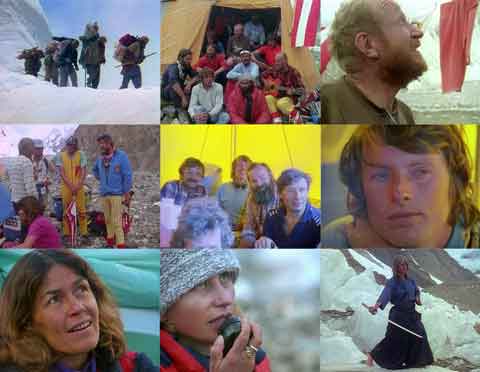
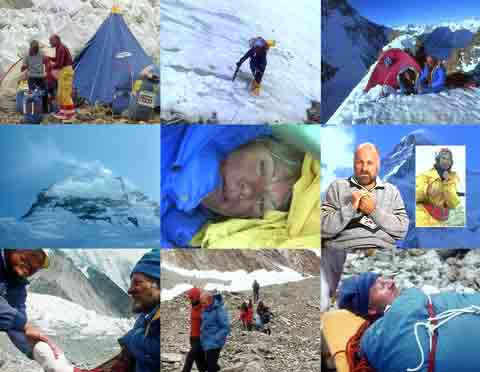
by Kurt Diemberger and Julie Tullis. Filmed on K2 in 1986. 60 minutes. This is the story of the tragic 1986 K2 season when nine expeditions converged on K2, 27 people reached the summit, but 13 were killed, seven of them after reaching the summit.
The film starts with the trek to K2 Base Camp, mainly showing the porters, making bread, trekking, and praying. We see the expeditions at base Camp, with Kurt and Julie meeting and interviewing many of the other climbers, including Al Rouse, Jim Curran, Goretta Casarotto speaking on a radio to her husband Renato Casarotto who was high on the mountain, Wanda Rutkiewicz (who became the first woman to climb K2 on June 23), the Austrian team including Willi Bauer, Alfred Imitzer, and Hannes Wieser. There is a touching scene with many climbers laughing and enjoying watching a movie.
Shot in the studio, Kurt Diemberger describes the tragic events of that season, including Willie Bauer and Kurt's own harrowing descent when a snowstorm with excessive wind and cold temperatures seven climbers, keeping them tent bound at Camp 4 for 5 days, with Julie Tullis dying in her sleep on August 7.
The film closes with Willi Bauer walking, while Kurt is carried on a stretcher to a helicopter to be flown out from base Camp.
The film quality is very good, with colour generally bright and vivid. I enjoyed the trek to Base Camp and seeing the many climbers at Base Camp, especially Julie Tullis meditating by practicing martial arts. I was disappointed in the brief actual climbing scenes with nothing high on the mountain.
12. K2 y Makalu
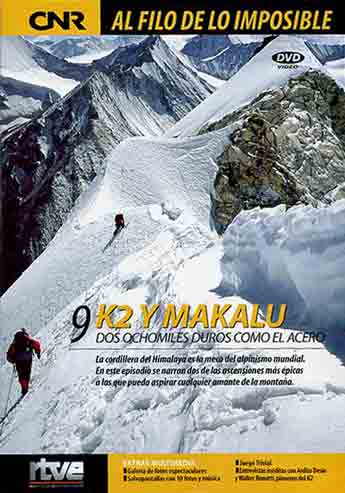

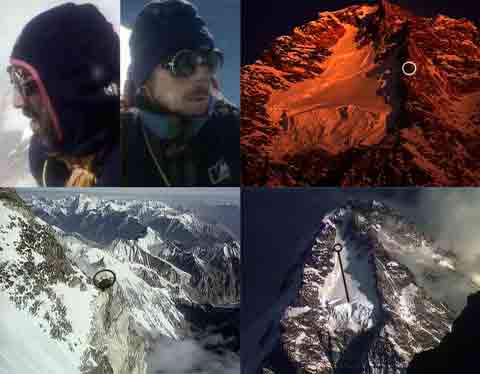
by Sebastian Alvaro. Al Filo De Lo Imposible, Spanish TV 1995. 36 minutes. Filmed in 1994. This film documents the 1994 Spanish K2 North Ridge Expedition. It features studio interviews with Doctor Ricardo Arregui, Juan Jose Sansebastian, Inaki Ochoa, and Ramon Portilla. This DVD also contains Makalu (filmed 2002, 53 minutes). Extras include interviews with Ardito Desio (14 minutes) and Walter Bonatti (17 minutes).
The film opens with doctors working on the severe frostbite of Spanish climber Juanjo Sansebastian. It then switches to the trek to K2 North Base Camp, using horse and camels. crossing rivers, and trekking under K2's North Face, and then setting up high camps. When an old fixed rope broke, Inaki Ochoa suffered an 80m fall, breaking his right arm and three ribs, and suffering nose injuries. He then had to be helped to painfully descend to base camp.
The first team climbed up the North Ridge, and on July 30, 1994 Jose Carlos Tamayo and Sebastian de la Cruz reached the K2 summit via the North Ridge. The final ascent and summit shots are from photos, including Jose Carlos playing the flute on the summit.
The next summit team then leaves base camp for their attempt, and climb up to camp 3, camp 4 and on August 4, 1994 Juan Ignacio (Atxo) Apellaniz and Juan Jose (Juanjo) Sansebastian also reached the K2 summit via the North Ridge. They had to bivouac above 8000m on the descent. In the morning, San Sebastian was swept away by an avalanche, but miraculously came to a stop 400m just above the top of the hanging glacier. He made it to camp 4, but then had to go back to help his exhausted partner Apellaniz, who started showing symptoms of altitude sickness. Despite the help he received from below, after seven agonizing days, Apellanitz died at camp II on August 10, where the whole team was delayed by a blizzard. San Sebastian returned home, but he paid for his adventure on K2 and his bravery with the amputation of seven fingers.
The video quality is good, not great. There really isn't much climbing footage. The film is really the interviews with the participants telling the dramatic story.
13. Karakoram


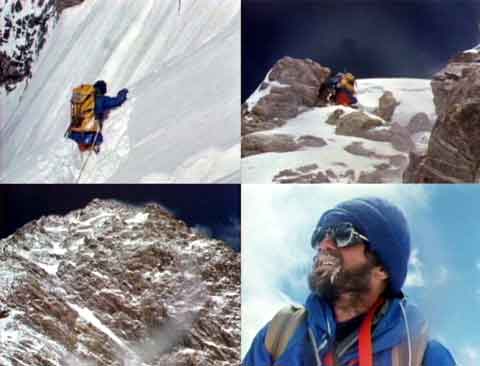
by Steve Marts. Filmed 1975. Release 1976. 47 minutes. This is the story of the 1975 American K2 Expedition attempting the unclimbed Northwest Ridge. The team was led by Jim Whittaker and included his twin brother Lou, Jim Wickwire, and famed photographer Galen Rowell.
The films shows hectic street scenes in Rawalpindi where the team waited two weeks for good flying weather. They fly past Nanga Parbat and get an aerial reconnaissance of K2 before landing at Skardu. The porters are selected and the trek to base Camp begins. We get a glimpse into the Balti people, their villages and their way of life, while the porters and expedition members trek along the Braldu river and onto the Baltoro Glacier. The expedition doctor Rob Schaller treats both porters and the villagers along the way. There are so many porters that when they stop for the night, the expedition looks like a village. The expedition has trouble with porters, but finally reaches Base Camp on the Savoia Glacier, three weeks behind schedule.
They pay off the remaining porters, set up their Base Camp tents, and unpack and repack the loads. They carry loads to Camp 1 and Camp 2, and climb up steep snow above Camp 2. They have to descend to Camp 2 when a 5-day storm blows in. After the storm, they descend to Base Camp and again climb above Camp 2 reaching the ridge at 21,500 feet. Towering above them was the K2 summit, but to reach it they still had to negotiate the pinnacles. They were hit by another 5-day storm and they descended, carrying down a sick high altitude porter using a stretcher. The return crossing a river on a scary rope bridge and pass villages now harvesting their crops.
The climbing story is fairly straightforward with good mountain views. This DVD is more about the Pakistani porters, villages and people, then about the climb itself. The video quality is good, with the colour a bit faded and washed out. The film does not show any of the personal conflicts that Rowell highlights in his book, In The Throne Room Of The Mountain Gods.